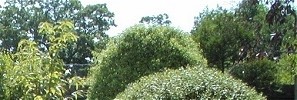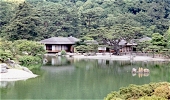
|
|
Consider your space; size, topography, surrounding
buildings, views outside of boundary,
soil type and orientation. Then choose a style, or blend of styles,
that will benefit from these
conditions. Make a scale plan on paper, place a marker showing north,
then sit and ponder... |
| Space |
Ryogen-in
Kyoto |
| A vital component. Single features
and group plantings can only succeed when given appropriate surrounding
space. |
 |
| Harmony |
Harmony and balance
are similarly vital for all planting, structures and the space they
occupy. Harmonise shapes and colour. Even though an evergreen composition
at the planning stage may appear monochrome, in reality the range
of greens can yield wide contrasts and variety. Consider leaf shape,
size and texture. Anticipate how autumn colouring will change the
scene and the effect of leafless deciduous plants.
Consider carefully the juxtaposition of mass
and space, and avoid symmetry. |
| Structure |
my garden |
Appreciate the value of vertical, horizontal
and diagonal accents.
These give the garden form, determine views and provide focus. |
 |
Achieved with trees, ponds, gravel areas, rocks
and planting groups.
Consider the effect of horizontal and vertical planes. Creating different
levels allows the eye to be directed. Think about views; will
the garden be viewed from a single point or, with a larger space,
will there be multiple views as the garden is explored, if so determine
specific points for these views and ensure that they blend.
Make use of the pyramid shape and triadic groupings,
especially with rocks. |
Shakkei 'borrowed
scenery'
This technique can be seen in many Japanese
gardens. Whilst the boundary provides a frame for your garden, suitable
outside views can be incorporated into your design. |
 |
 |
This may be as simple as
growing larger shrubs near a rear fence, merging the outside foliage
to extend the garden.
Or, on a rather more grand scale, using a wooded mountain as at Ritsurin
Park in Takamatsu |
|


